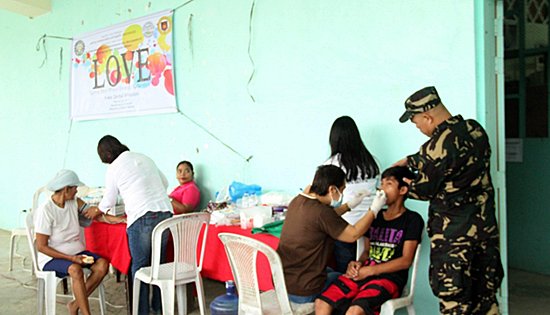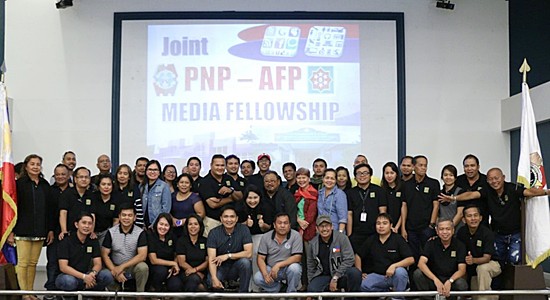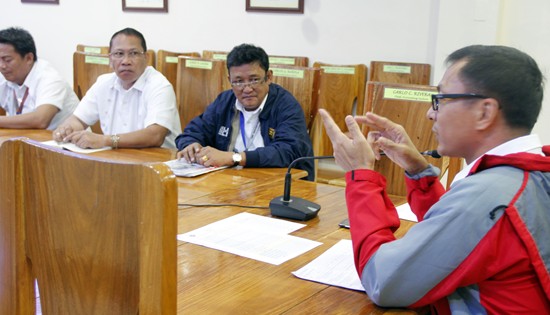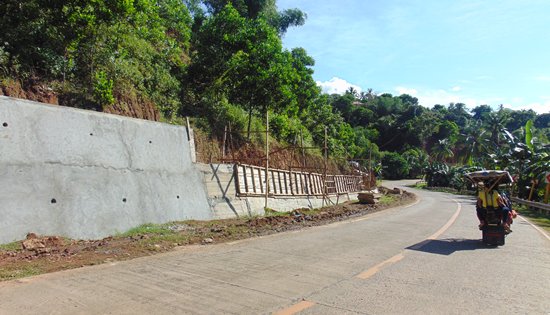14IB with 1368th
Dental Company joins Eastern Samar State University for Dental Mission
in Maydolong

By
DPAO, 8ID PA
February 27, 2017
ORAS, Eastern Samar –
A dental mission spearheaded by Eastern Samar State University (ESSU)
in partnership with 14th Infantry (Avenger) Battalion and the 1368th
Dental Company 8th Infantry Division was conducted last February 23,
2017 at ESSU-Maydolong Campus in connection with the National Dental
Month of its BEED Program.
The dental services were
rendered by the 1368th Dental Detachment under Lt. Col. Edelberto R
Tacad with the civilian dentist from the Rural Health Unit of
Maydolong headed by Dr. Aurora B Borja, Dentist III.
Faculty and staff of ESSU
Maydolong also distributed medicines to the recipients. More or less
sixty local populace of Maydolong, Eastern Samar and its barangays
benefited from the dental mission.
Lt. Col. Manuel Leo Q Gador,
Commanding Officer, 14th IB, said that the unit will continue its
endeavor of helping partner LGAs, NGOs and other institutions in
conducting such activities in which the people, especially the less
fortunate families, are given the opportunity to avail of the free
dental services.
Meanwhile, Dr. Vicky Myril
G. Yadao, Ph.D., College Administrator of ESSU Maydolong expressed
gratitude to the officers and men of the Philippine Army who had
helped them in making the event a success.
Sueno: Change is
coming in barangays thru Seal of Good Local Governance
Press Release
February 26, 2017
QUEZON CITY – Heydays
are coming for barangay local government units (LGUs) as the
Department of the Interior and Local Government (DILG) is bringing its
Seal of Good Local Governance (SGLG) program down to the barangay-level.
DILG Secretary Ismael ‘Mike’
D. Sueno said, “Just like the SGLG for provincial, city and municipal
LGUs, the SGLG for Barangays will also have an incentive after being
conferred the Seal.”
The incentive, he said, will
come in the form of cash reward to be used for development projects in
the barangay.
“Ang malinis na pamamahala,
sa barangay ang simula. Barangays are the bedrock of the government.
The national government is uplifting and strengthening barangays by
assisting and encouraging them towards the practice of good governance
which comes with a reward,” he said.
The SGLG for Barangays, he
said, aims to make barangay governments accountable, transparent,
participative, and effective.
Akin to the current SGLG,
the barangay SGLG will assess barangays based on the following key
areas: peace and order, financial administration, disaster
preparedness, social protection, business friendliness and
competitiveness, and environmental management.
On Peace and Order
Barangays will be assessed
on their maintenance of peace and order in the community through the
implementation of the Katarungang Pambarangay (KP) or Barangay Justice
System (BJS), an alternative and community-based mechanism for dispute
resolution of conflicts between members of the same community.
Barangays will also be
monitored on their creation and mobilization of their Barangay Peace
and Order Council (BPOC) and Barangay Anti-Drug Abuse Council (BADAC),
prevention of the proliferation of illegal drugs, and provision of
support mechanisms to ensure the protection of constituents from
threats to life and security.
“For the sub-indicator on
BADAC, a barangay gets perfect score if the barangay is drug-free. If
there is no data on drug-affectation as well as presence of mild,
moderately up to severe affectation, a barangay gets zero score,”
Sueno emphasized.
Barangays must also be able
to maintain their Records of Barangay Inhabitants (RBIs) or any
similar document.
On Financial Administration
To measure the performance
of barangays on financial administration, they will be evaluated on
their adherence with the accounting and auditing standard and
compliance with the Barangay Full Disclosure Policy (Good Financial
Housekeeping); and sound fiscal management (Financial Performance)
based on the percentage increase of their local resources.
The Barangay FDP aims to
eliminate graft and corruption in all government transactions at the
barangay level by directing all barangay officials to post the
following documents in a conspicuous area inside the barangay hall and
on the barangay’s official website: Annual Budget, Summary of Income
and Expenditures, utilization of the 20 percent component of the
Internal Revenue Allotment, Annual Procurement Plan, Itemized Monthly
Collections, and List of Notices of Awards.
On Disaster Preparedness
Sueno said that the
indicators of disaster preparedness of barangays are: the
functionality of the Barangay Disaster Risk Reduction and Management
Committee (BDRRMC); accomplishment rate of the activities/projects
reflected in the BDRRM or community-based DRRM plan; extent of risk
assessment and Early Warning System (EWS); and extent of preparedness
for effective response and early recovery.
On Social Protection
To gauge the social
protection being done by barangays, the DILG will consider the
indicators of the functionality of their Violence against Women and
their Children (VAWC) Desk; accessibility to health services in the
barangay; participation rate of children 0 to 4 years old in their Day
Care Center; functionality of their Barangay Development Council (BDC);
and representation of civil society organizations (CSOs) in the
barangay-based institutions (BBIs).
On Business Friendliness and
Competitiveness
A barangay’s business
friendliness and competitiveness, on the other hand, will be
determined based on the indication of their enactment of a barangay
tax ordinance; and issuance within a week of a barangay certificate as
a requisite of setting up new business in their area.
On Environmental Management
Barangays would also have to
do good in environment management based on the functionality of their
Materials Recovery Facility (MRF); percentage of households practicing
segregation of waste at source; and functionality of their Barangay
Ecological Solid Waste Management Committee (BESWMC).
After 31 years,
people still clamor for fundamental change - Karapatan
By KARAPATAN
February 25, 2017
QUEZON CITY –
Targeted political killings, the slate of illegal arrests of leaders
and members of progressive organizations, intensified military
operations in communities, a justice system that favors the rich and
powerful, the continuing oppression of peasants and workers and the
domination of US interests in the country remain as palpable
realities, thirty one years after Edsa 1.
Has this country really
achieved change when repressive state policies continue? Have we
really seen change when farmers remain landless, rights continue to be
violated, and the Filipino people’s interest remain subjugated to
imperialist powers?" asked Karapatan secretary general Cristina
Palabay on the 31st commemoration of the EDSA people power.
"What we have seen in the
years following the Marcos dictatorship are forms of repression,
masked under the banner of democracy. Killings in the name of the war
on drugs, the possible reimposition of the death penalty, the revival
of the Philippine Constabulary and the military's involvement in the
war on drugs under the Duterte administration are more recent
worrisome issues," she stated.
"Scores of activists and
revolutionaries who work for radical change continue to be targeted
and the number of political prisoners remains on the rise," Palabay
continued.
Karapatan has documented 402
political prisoners in the country as of February 2017, 30 of them
arrested under Duterte and 283 under BS Aquino III. "Even this
practice of jailing activists and political dissenters has continued
throughout the administrations after Marcos, tolerated and enabled by
people who, given recent developments, are now at the end of this
repressive State maneuver," said Palabay.
Sen. Juan Ponce Enrile’s
statement that there are no political prisoners is not surprising,
coming from the mouthpiece of government narratives since Martial Law.
"His efforts to delegitimize the struggles of activists and
progressives through these kinds of statements are classic examples of
the elite's disdain for genuine change. His release on the basis of
humanitarian grounds should have been accorded to the people who most
deserve it – the political prisoners who have fought hard alongside
the marginalized in this country," Palabay said.
Karapatan also recounted
that the conferment of hero's honors on former dictator Ferdinand
Marcos Sr. is a betrayal of what the EDSA "people power" stood for.
"The Filipino people toppled a dictator but the Supreme Court and
Pres. Duterte allowed him a hero’s burial. On the other hand, the
victims of the Marcos dictatorship have yet to be indemnified and the
Marcos’ stolen wealth yet to be returned. This can only be the result
of the shameless accommodation of the ruling elite to stay in power,’
said Palabay.
Aside from allowing a hero’s
burial for Marcos, Duterte also cancelled the peace talks on February
3, 2017, ramped up the implementation of counter-insurgency program
Oplan Kapayapaan with the military's declaration of an all-out-war,
and subsequently terminated the Joint Agreement on Security and
Immunity Guarantees (JASIG). "Duterte won with his catchphrase 'change
is coming.' We should thus demand and protest the Duterte
administration's unfulfilled promises. We strongly call on the
President to stop the fascist attacks against the people and to
continue the peace talks with the National Democratic Front of the
Philippines,’ Palabay added.
"EDSA 1 showed how a
dictator was ousted through the people's collective strength and
actions. As long as interests of imperialists, landlords and political
clans continue to dominate, there is no doubt that the people will
continue to struggle in all forms to achieve fundamental change,"
Palabay concluded.
1st Joint AFP-PNP
Media Fellowship conducted in Eastern Visayas

By DPAO, 8ID PA
February 23, 2017
CAMP LUKBAN, Catbalogan
City – Envisioning the role of media in the society as one of the
pillars of democracy, the 8th Infantry (Stormtroopers) Division
together with Police Regional Office Region 8 organized the pioneering
joint AFP-PNP Media Fellowship to all media members in Eastern Visayas
held at Matapat Hall, PRO8, Camp Ruperto Kangleon, Palo, Leyte last
February 22, 2017.
The activity which was
attended by 56 media practitioner from different outlets in Region 8
aimed to strengthen the relationship of the AFP and PNP to the press.
It also gave an opportunity for the officials of 8ID and PRO8 to
discuss with the media about the AFP Development Support and Security
Plan “Kapayapaan” and the PNP’s program and effort in cleansing and
exercising disciplinary actions to any police members that violate the
policies and directives especially those who are involved in any
illegal activities, respectively.
PCSupt Elmer C Beltejar,
said in his message: “The PNP in Region 8 looks up to the media as our
partner in the pursuit of genuine change. Undeniably, the media
possesses an immense power needed for the country to function well as
a democracy.”
Maj. Gen. Raul M Farnacio
AFP appreciated the time and efforts of the press in taking part of
the fellowship. “I want to personally thank 8ID Press Corps for
continuing to play an integral role in bringing the Army in Eastern
Visayas, its accomplishments, and its development projects to the
consciousness of the Filipino people. And I know we can now count on
the members of the PNP Press Corps to give additional voice for our
call for peace and unity in Region 8,” Farnacio said.
SFDEO to build
P402M worth of flood control projects

By DONNA C. DEBUTON
February 21, 2017
CALBAYOG CITY – DPWH Samar
First District Engineering Office to construct an appropriated amount
of P402 million worth of Flood Control Projects under GAA CY2017.
The District Office has a
total of 7 Flood Control Projects for this year: Construction of Flood
Control Structures along Jibatang River (upstream), Brgy. Lonoy,
Calbayog City costing P100M; Construction of Flood Control Structures
along Gandara River (upstream) Brgy. Ngoso, Gandara, Samar amounting
P80M; Construction of Flood Control structures, Labuyao River Control
(Sta. 0+000-Sta. 0+352), Calbayog City costing P45M;
Construction of
Flood Control structures along Calbayog River (upstream) Brgy.
Hamorawon, Calbayog City amounting P50M; Rehabilitation/Improvement of
Flood Control Structure upstream of Jibatang River
(Sta.0+348.6-Sta.0+697.2) at Brgy. Lonoy, Calbayog City amounting to
P50M; Construction of Flood Control structures along Binaliw River
(Phase II) Brgy. Binaliw, Calbayog City costing P28M; and Construction
of Flood Control structures along Arapison River, Brgy. Cagsumje, Sta.
Margarita having an appropriation of P50M.
These Flood Control Projects
will mitigate floodings in the above-mentioned barangays and will
prevent further damages to lives and properties.
Approved Plans and Program
of Works (POW) are already advertised for procurement. According to
implementing section, notices of awards and notice to proceed will be
issued anytime this week for contractors to implement these Flood
Control Structures to beat the deadline set for completion.
Care for your
kasambahays, register them in barangays - Sueno
Press Release
February 18, 2017
QUEZON CITY – The
spirit of love is still up in the air this February as Secretary
Ismael ‘Mike’ D. Sueno of the Department of the Interior and Local
Government hovers the welfare of domestic workers or kasambahays in
the country.
In a directive to local
chief executives, Sueno urges them to ensure the implementation of
Republic Act (RA) No. 10361 or Batas Kasambahay which requires every
employer to register all domestic workers under their employment in
the Registry of Domestic Workers in the barangay also called as
Barangay Registration of Kasambahays.
“Kasambahays have a big role
in keeping socioeconomic activities running. They take care of
households and look after their employers’ children in order for their
bosses to go to work or attend to their enterprise,” he said.
“Their wellbeing ought to be
taken cared of just like workers in the formal public and private
sectors,” he added.
The DILG Secretary also
called on all punong barangays through a directive to enact local
ordinances in support of the Batas Kasambahay and to implement the
Barangay Registration of Kasambahays in their area of jurisdiction.
“Registering kasambahays is
both beneficial to kasambahays and their employers,” he emphasized.
“I also encourage barangay
officials to discuss your implementation of the Batas Kasambahay
during the coming law-mandated conduct of Barangay Assembly Day this
first semester of the year, which will be on March 25,” he said.
Under Batas Kasambahay, a
domestic worker or kasambahay is any person engaged in domestic work
within an employment relationship such as, but not limited to: general
househelp, nursemaid or “yaya”, cook, gardener, or laundry person, but
shall exclude any person who performs domestic work only occasionally
or sporadically and not on an occupational basis.
The term does not include
children who are under foster family arrangement, and are provided
access to education and given an allowance incidental to education,
i.e. “baon”, transportation, school projects and school activities.
Barangay Kasambahay Desk
In July 2013, the DILG
directed barangays to have Kasambahay Desks. Barangay chairpersons
were ordered to devise a system to ensure the registration of all
kasambahays in their barangays including an on-line registration
through their official website or e-mail.
The KR Form 1 and the
Kontrata sa Paglilingkod sa Tahanan are available at the barangay and
city or municipal Public Employment Service Office (PESO). Both forms
are also downloadable at www.dilg.gov.ph and www.dole.gov.ph.
In case of termination of
the contract, employers ought to immediately notify the Kasambahay
Desk for updating purposes.
The disclosure of
information about the kasambahay and the employer by the barangay and
the local PESO is subject to compliance with the requirements of RA
No. 10173 (Data Privacy Act of 2012) and other existing laws,
otherwise, violators shall be subjected to fine or imprisonment.
|

Construction
of Slope Protection along Biliran Circumferential Road is
on-going with 62% accomplishment as of January 31, 2017. Other
than the slope protection structure, concrete paving of widened
shoulders and construction of concrete canal are included in the
project. The above road section is prone to landslide hence
slope protection structure is recommended to prevent recurrence
of landslide which happened during the onslaught of typhoon
Henry on July 20, 2014 that caused closure of the road. |
DPWH-Biliran DEO
fastracks on-going FY 2016 high impact projects
Press Release
February 15, 2017
NAVAL, Biliran –
Above P40M remaining FY 2016 projects implemented by the Department of
Public Works and Highways (DPWH) - Biliran District Engineering Office
is being fast-tracked for completion until first quarter of 2017. As
of January 31, 2017, Biliran DEO reports 63 projects completed with
three projects on-going with an accomplishment of 92.64%.
The District has been
allotted P683.745M under FY 2016 DPWH Infrastructure Program. Out of
the allotted amount, P135M was implemented by DPWH Regional Office 8
which involves the Rehabilitation of a section of Maripipi
Circumferential Road, while 66 projects are implemented by Biliran DEO.
Some District Offices
including Biliran DEO has only been allowed to implement projects
below P50M, projects above of the said amount are
undertaken/implemented by the DPWH Regional Office.
Adongay reported that two
projects of the largest amount allotted to Biliran DEO is still
ongoing which is the P45M slope protection project along Biliran
Circumferential Road (BCR) and P43M construction of Biliran diversion
road with an accomplishment of 62% and 58%, respectively as of January
31, 2017.
According to Adongay, the
Construction of Slope Protection along Biliran Circumferential Road
encountered some problems caused by lapses of the contractor and
unfavorable weather conditions that hinders the contractor to smoothly
perform the project implementation.
Meanwhile, the Construction
of Biliran Diversion Road was hindered to proceed with the embankment
activities due to continuous heavy rains. Furthermore, one of the
landowners affected by the road opening refused to sign “Permit to
Enter” for the reason that the amount offered per current market value
of his parcel of land is below of what he is expected. The landowner
is asking for P2,000 per sq.m. of his land that is affected by the
Road-Right-Of-Way (RROW), however, the current market value of an
agricultural land is P21.45 only.
The office is on the process
of negotiations with the concerned land owner with regards to the
value of the affected parcel of land.
The completion of the
diversion road project will serve the traveling public coming from
Tacloban City, Ormoc City, Baybay City and from other neighboring
municipalities going to the northern and eastern part of Biliran
Province and vice versa in a much safer and faster transport of goods
and services and at a reduced travel time. The population to be served
by the road ranges from 120,000 to 135,000, 7 Municipalities and 50
Barangays.
Another FY 2016 project
eyeing for completion is the on-going P8.7M replacement of permanent
weak bridge-Banlas bridge along Maripipi Circumferential Road.
Adongay revealed that the
delay was attributed due to unavailability of sand and gravel
aggregates in Maripipi Island. Adongay explained that hauling it by
barge with the quantity required is impractical and will only entail
higher cost. Hence, the contractor suggested to have the delivery
together with the delivery of the sand and gravel for the concreting
of Maripipi Circumferential Road.
Adongay said that the
contractors of each projects were advised to render over time work
24/7 to complete the projects on the target date.
PH exports yield
growth in December 2016
By DTI-IPG
February 15, 2017
MAKATI CITY – The
Department of Trade and Industry sees sustained growth for exports in
2017 as Philippine exported goods yielded a 4.5% growth in December
2016 with a total of $4.71 billion in export revenues from $4.660
billion in the same period in 2015.
"As we implement new
strategies in diversifying our markets and upscaling our products and
services amidst the slowdown in global trade, we hope that our exports
will continue to improve in the next quarters” said DTI Industry
Promotion Group Undersecretary Nora K. Terrado.
In a report released by
Philippine Statistics Authority (PSA), increase in the top five (5)
major export commodities contributed to the growth which include
coconut oil (crude and refined; 146.5%), other mineral products
(104.5%), metal components (66.4%), chemicals (42.1%), and other
manufactures (35.8%).
While electronic products
experienced a 2.8% decrease in total receipts as compared to 2015
data, these remained to be the top export product of the country with
total receipts of $2.451 billion, accounting for 50.3% of the total
exports revenue in December 2016. Other Manufactures ranked second
with 7.2% share to the total export receipts. It recorded an increase
of 35.8% from December 2015 value of $257.32 million. It is followed
by Machinery and Transport Equipment with export revenue of $227.05
million, Woodcrafts and Furniture with total sales of $202.14 million,
and Ignition Wiring Set and Other Wiring Sets Used in Vehicles,
Aircraft and Ships with $153.72 million export sales.
“Notable 67.5% increase in
the exports of our Agro-Based Products in December 2016 is a good
indication that our agrisector will be up in the coming months. We
hope to see more of this trend to fully boost our exports,” added DTI
Export Marketing Bureau Director Senen M. Perlada.
Agro-based products shared
7.7 % of the total exports in December 2016 which amounted to $377.30
million.
Total exported goods to East
Asia increased compared to other top Philippine exports destination
such as ASEAN member countries, USA, and European Union member
countries. Merchandise exports to East Asia increased by 9.4% with
total revenue of $2.556 billion million from $2.337 billion recorded
in the same month in 2015. Japan remained to be the country’s top
export destination, with revenue amounting to $946.28 million,
comprising 19.4 percent share of the total exports.